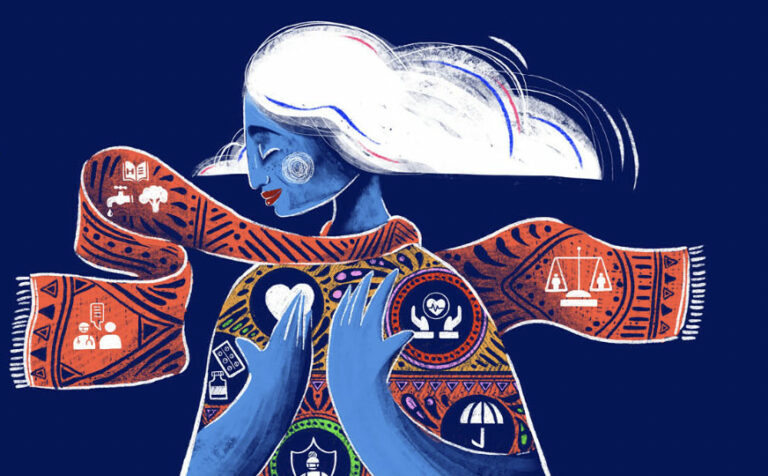
Blog: Resilient Crimea: the History of the Crimean Tatar people
Think of the map of Europe. What do you see? Dozens of countries appear on maps in schools, universities, and on the Internet. But what happens if we look more closely at the European continent? We will be able to see 87 different ethnic groups with their unique history, culture, traditions and language. One of these is the Crimean Tatars, a people of about five million, who live on the picturesque Crimean Peninsula in Ukraine, illegally annexed in 2014 by the Russian Federation.
Crimean Tatars are a Turkic people, indigenous to the south of Ukraine, in the steppes of Tavria and the mountains of Crimea. “A great nation with a great history” is how you can describe the Crimean Tatars, because, despite experiencing many occupations, genocides, and persecutions, they still stand proudly and protect their national identity.

History
The first mention of the Crimean Tatars on the territory of modern Ukraine dates back to the 13th century, mostly adopting Islam in the 14th century, and beginning to build their nation in the southern regions of the Black Sea steppe. By the 15th century, they were able to establish their own state – the Crimean Khanate, an Ottoman vassal state from the 16th to the 18th century, which served as a basis for the formation and development of the culture and traditions of these people.
In 1783, the Crimean Khanate was occupied by the Russian Empire, and since then, the era of oppression of the Crimean Tatar people began. Oppression by the Russian administration and expropriation of land from Crimean Tatars caused a mass emigration of Crimean Tatars to the Ottoman Empire. Their descendants now make up the Crimean Tatar diaspora in Turkey, Bulgaria, and Romania. The two main waves of emigration occurred in the 1790s and 1850s. This caused the decline of agriculture and almost complete depopulation of the steppe part of Crimea. It was at this time that most of the Crimean Tatar elite left Crimea. Alongside this, came the Russian settlement of Crimea bringing Russian settlers from other parts of the empire. All this led to the fact that of the million Crimean Tatars who lived in Crimea when it became part of the Russian empire, less than 200,000 remained by the end of the 19th century.
With the Russian Revolution of 1917 and the collapse of the Russian empire, the Crimean Tatars briefly proclaimed the Crimean People’s Republic in December 1917, but it was soon overcome by Bolshevik forces in January 2018 and became part of the Soviet Union.
In 1941, Crimea was occupied by Nazi Germany, which held the peninsula until 1944, unleashing terror against the civilian population. Following its recapture by the Soviets, Stalin on 18 May 1944, ordered the deportation from Crimea of all Crimean Tatars, regarded as unreliable. In total, the Soviet authorities deported 193,865 Crimean Tatars from the peninsula, mostly to Central Asia. It was not until the perestroika era in the late 1980s, that the Tatars were able to return to Crimea.
When Ukraine gained independence in 1991, the new state established a system of national self-government of the Crimean Tatars, and Crimean Tatars consistently supported the territorial integrity of Ukraine and opposed pro-Russian separatism. When Russia illegally annexed the Crimean peninsula from Ukraine in March 2014, it barred Crimean Tatar leaders from entering Crimea and banned their representative body, the Mejlis of the Crimean Tatar People. The UN has reported that over 10,000 people left Crimea after the annexation in 2014, most of them Crimean Tatars and Tatar leaders have suffered from systematic intimidation and harassment, with many of them imprisoned.
Culture
Crimean Tatars practice Islam and therefore celebrate most of the Islamic holidays, including Oraza Bayram (the Crimean Tatar name for Eid al-Fitr), which concludes the 30-day fast from sunrise till sunset during the holy month of Ramadan. The most sacred is the 27th night of the month of Ramadan, which is called Qadir Gejesi. It is believed that it was on this night that the Koran was given to Muslims. Tatars prepare for it for several days by cleaning their homes and cemeteries, putting on new clothes, and more. The day before this holiday, they celebrate arfe gecesi: in the evening, they prepare a festive meal including qatlama (a dish similar to pancakes), çiberek (deep-fried pastries filled with minced meat and onions), and sweets.
Crimean Tatars also celebrate national holidays, one of which is Hıdırellez, an ancient Turkic feast of agriculture, dedicated to the completion of the spring harvest and the herding of livestock to summer pastures. It is celebrated with dances, songs, folk festivities, games, and competitions in national Kuresh wrestling. The name of the holiday, Hıdırellez, which has pre-Islamic roots, includes the Muslim names of two saints: Hıdır and Ilyas. According to legend, the saints continuously travel around the world, helping people: Hıdır goes around the earth to the right, and Ilyas to the left, and they meet where the farm work and the cattle turn are finished.
“Oh, beautiful Crimea” is a Crimean Tatar folk song that describes all the love Crimean Tatars have for their land, even when they were deprived of the opportunity to live there. However, the spirit of the Crimean people is unconquered and there is no doubt that the flag of the Crimean Tatars will one day fly over the entire Crimea.
Author: Vuzkyi Kyryl (YEA from Ukraine)
Peer-reviewed by: Atyia Al-Hammud (YEA from Ukraine), Anna Romanovska (YEA from EU/UK)
This blog post was produced in collaboration with the Dialogue Initiative EU-Ukraine Working Group’s “Crimean History and Culture” series
LATEST

How you can help the planet every day

Building Europe: Poland’s experience of joining the European Union and lessons for Ukraine

World Health Day 2024: My Health, My Right

EUREKA MEETS EUROPE – opportunities to develop and study. My experience

Can you wear pink in the workplace?
More campaign pages:
Interested in the latest news and opportunities?
This website is managed by the EU-funded Regional Communication Programme for the Eastern Neighbourhood ('EU NEIGHBOURS east’), which complements and supports the communication of the Delegations of the European Union in the Eastern partner countries, and works under the guidance of the European Commission’s Directorate-General for Neighbourhood Policy and Enlargement Negotiations, and the European External Action Service. EU NEIGHBOURS east is implemented by a GOPA PACE-led consortium. It is part of the larger Neighbourhood Communication Programme (2020-2024) for the EU's Eastern and Southern Neighbourhood, which also includes 'EU NEIGHBOURS south’ project that runs the EU Neighbours portal.

The information on this site is subject to a Disclaimer and Protection of personal data. © European Union,